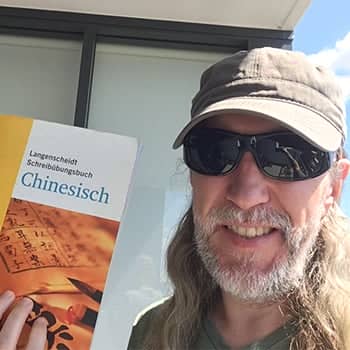
Well, what if that isn’t true?
I certainly found Chinese to be a lot easier than I thought it would be, first when I was invited to teach memory techniques at the Chinese Language Institute in Guilin. Then later when I studied Chinese at the Confucius Institute in Brisbane.
So let me ask you this:
What if you had a simple way to learn tones, characters and rapidly memorize entire phrases within minutes? And what if you could do it all with minimum repetition, all under an hour a day?
And the best part?
You can even take breaks and still make progress.
Want a guide to how I’ll help you do exactly that in this post? Here’s what we’ll cover:
- How To Learn Chinese In 15 Steps
- More Power Tips And Troubleshooting Advice For Learning Chinese
- How To Craft The Best Way To Learn Chinese
If all of this sounds too good to be true, stick around.
Everything I’m about to teach you is not only the best way to learn Mandarin – it’s the most scientific way. And it’s all based on my years of applying my PhD skills to studying mnemonics to learning tasks like learning Chinese.
How To Learn Chinese In 15 Steps
Step 1: Get started and start speaking immediately
When I needed to learn as much spoken Mandarin as possible in less than three months, I looked to my friends Benny Lewis and Olly Richards.
Benny is famous for a few major rules when it comes to memorizing a pile of language-related information fast: Speak from day one and create missions.
Olly also has some great rules: Choose no more than:
- one textbook
- one video course
- one audio program
- one teacher…
… at least to start.
By following these simple principles, you start gaining traction immediately, without overwhelming yourself.
The question is:
How do you start speaking immediately? Well, once you have the best possible materials, you can read out loud from them. Later, you can repeat what you hear on recordings (such as Pimsleur) and be talking with native speakers within a week or less when you follow all 15 tips on this page.
Step 2: Choose the best possible materials
The trick to memorizing information fast in making sure you really do choose the best possible materials.
What are the best?
In this case, you’re going to do some self-exploration and market research. No one can tell you exactly and sometimes you have to experiment to find the best possible materials.
Example of choosing a great book for learning Mandarin
For me, I went directly to a Chinese character book. I read German, so I chose one in that language so I could practice “laddering.” This is a technique polyglots use to keep sharp in one language they’ve learned while stacking on another.
If you can’t do that (yet), here are some things to consider. Look for a book that:
- Contains short lessons that help you achieve your goals (if you’re not traveling, for example, look for something oriented more to Chinese vocabulary and phrases used in daily life)
- Contains link or downloads to audio or video components
- Contains instructions on learning pinyin with clear instructions for each letter
- Contains a vocabulary list organized by pinyin in the back
In my case, I broke Olly’s “law” of choosing just one book because the character book included no phrases. So I added a second book of grammar that includes phrases.
What about getting a dictionary? By all means, you can, and for that I suggest the Pleco app, ideally with the Outlier Linguistics add-on.
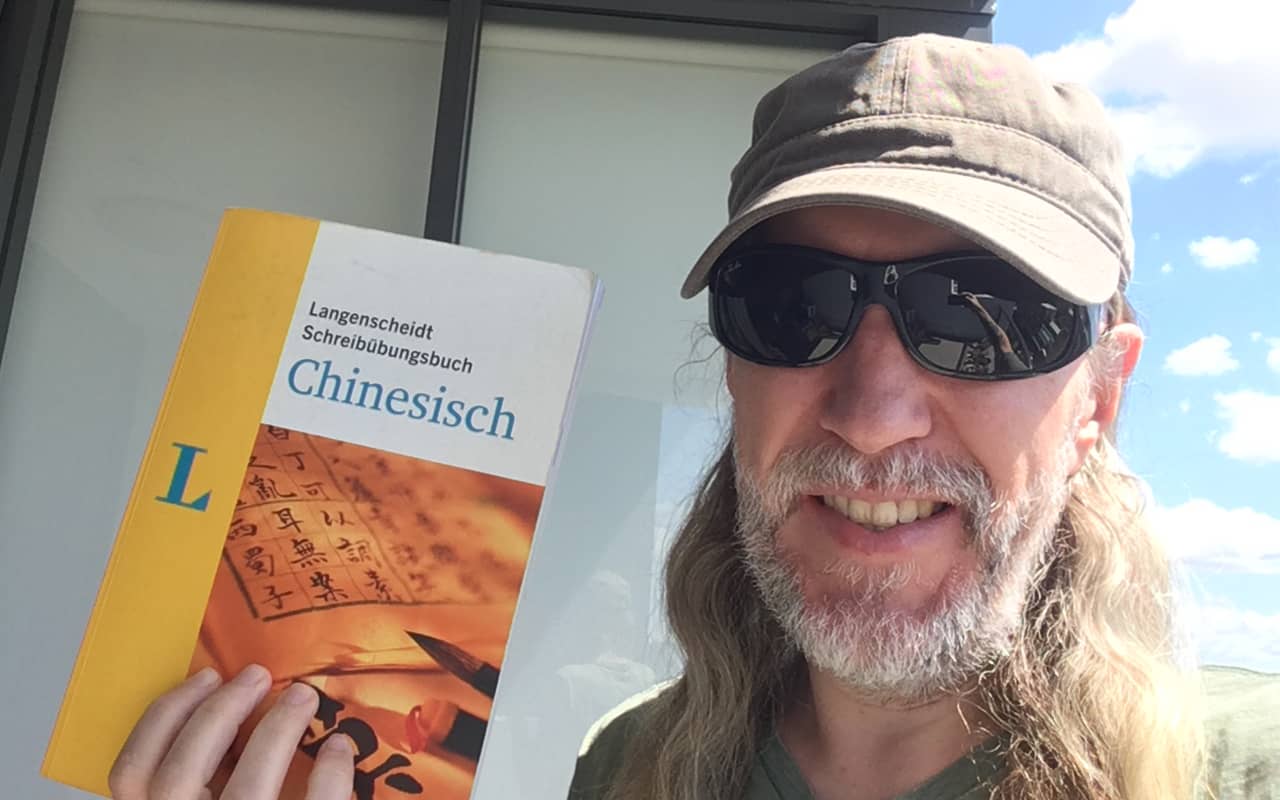
Note: My choices also reflect the use of memory techniques. We’ll talk about those in a bit.
Example of choosing a suitable video or audio program
Let’s face it: the Internet is packed with podcasts and videos to help you learn to speak Chinese.
But you really should find just one and stick with it from beginning to end.
The reason to focus on just one program at a time is to help your brain see the big picture. Later, you can pick and choose from different sources, but even then, you’ll be best served by completing one course at a time thoroughly.
Note: The exception to the rule is if you really can’t stand something about the format. But that should be pretty rare if you’ve done your research and read reviews from other successful language learners.
When I first started with Chinese, I went with Pimsleur. I’ll talk about how to work with such a program in a moment. The point for now is simply this:
I made great progress with my Chinese not just because of the learning techniques we’re discussing on this page. I also made progress because I did not constantly interrupt myself with endlessly searching for and trying other courses. Olly’s advice stuck with me.
Example of choosing a teacher
Identifying great teachers is trickier than finding books and courses. But one of my favorite sources is italki. You can find speaking partners for free on the site, but I recommend you hire people. Here’s why:
Any “tandem” language learning service means that you’re not really “sharing” time with a native speaker. In reality, you’re competing for it. I spent dozens of hours trying to trade my time with people who constantly switched to English because they naturally want as much time speaking it as possible.
When you hire a teacher, they are focused solely on you and your goals. You just have to make sure that they understand your goals and are a good fit for at least a weekly session over a 90 day period. And the only way to find out who will be a great teacher is to try holding sessions. I’ll share some tips on maximizing your time with Mandarin teachers in a moment.
Summing up: Use Limits To Choose Your Chinese Learning Materials
My mentor Tony Buzan once told me that “the rules will set you free.”
When learning a language on your own, you need to create your own rules. The ones I learned from Olly about choosing just a few learning materials and working with them thoroughly were golden for me.
Step Three: Explore and Harness The Big Five Of Language Learning
“The Big Five” is my fancy name for something called the levels of processing effect. Basically, it tells us that the more senses and processes we tap into, the more quickly we learn. The five that I rely upon heavily are:
- Reading
- Writing
- Speaking
- Listening
- Memorization

There are many ways to get all of these activities into just 15-20 minutes a day, ranging from activities with your teacher to using certain apps. For example, Beelinguapp has some decent short stories. You’ll see the Chinese characters and hear native speakers for most of the stories.
Even better is Chinese Conversations by Olly Richards, who I mentioned above. Not only do you hear native speakers engaged in dialogues real people would actually hold, but you also get vocabulary lists. Plus, Olly teaches you a streamlined process that is much like the Big Five you just learned about.
Later in this post, we’ll talk about each part of the Big Five, especially memorization.
Step Four: Create Missions
We’ve talked about harnessing the power of limits when learning Chinese. This is so important, and the best way to do this is through some self-analysis of what you want to be able to say.
A lot of people get hung up on Chinese word frequency lists. Although they are useful, they are not and cannot be the holy grail of learning the language. You need to bring your own context to the game.
For example, the first time I went to Beijing, there was no way I could have known in advance that I would want to talk about marriage in Mandarin. So there was no point in focusing on vocabulary or phrases related to this topic. My main mission was to get through at least two levels of Pimsleur for Mandarin and meet with teachers online 2-3x a week.
To take another example, the last time I went to the zoo, I made it my mission to memorize 10 animals by their name in Chinese.
What should your initial missions look like?
- Mission One: Gather your learning material and focus on the power of limits
- Mission Two: Schedule time on your calendar for when you’re going to study the book and program you chose
- Mission Three: Schedule your meetings with teachers, ideally booking out as many in advance as possible after you’ve found a suitable match
- Mission Four: Learn the sounds of pinyin
- Mission Five: Keep following the programs, but also identify things you want to say that aren’t included in them to discuss with your teacher
- Mission Six: Identify themes related to your interests
- Mission Seven: Get started with characters, etc…
There are many more missions I could list, but let’s focus on Mission Six because it’s really important.
My friend Luca Lampariello talks a lot about finding topics you’re interested in and then starting to translate them into your mother tongue. I’m big into memory, so naturally I chose a book on memory in Mandarin to start working with to expose myself to characters, grammar and a general sense of how the written language works.
Step Five: Bring Your Missions To Your Learning Sessions And Record Them
I record every session with language learning teachers I hold.
Why?
Because that way I can focus on the moment and not worry about “losing” any words or phrases from the session.
I prefer a software called Screenflow for recording sessions. I have the textbook or teaching materials on the screen and my teacher on Skype. Then, whenever I want, I can go back through the lesson and make notes and put words and phrases into my Memory Palace Network for Chinese.
Note: The first “mission” I brought to the teacher was to go through lesson one of the Pimsleur program and some of the vocabulary I’d picked up from the Chinese character book I’d decided upon.
To organize words and phrases, you can:
- Write them in a notebook
- Place them on index cards (drawing works best)
- Memorize them directly
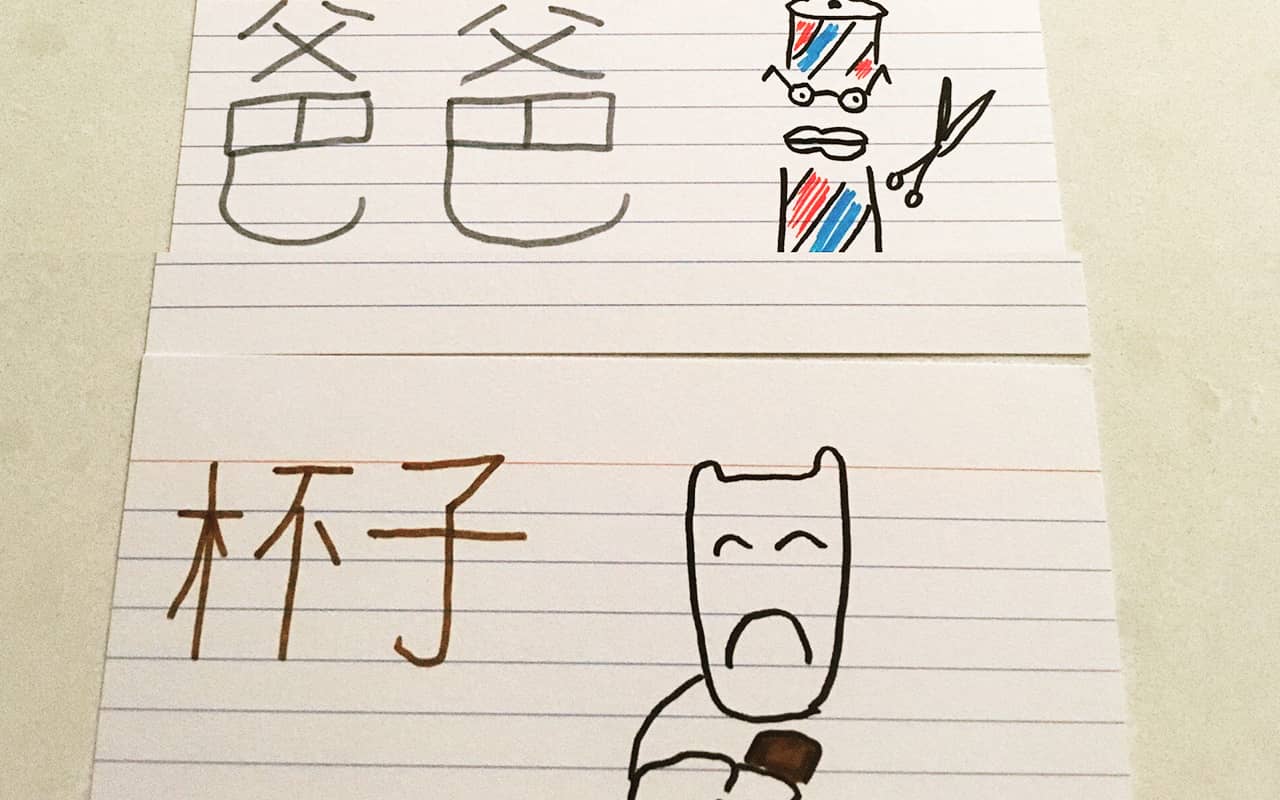
In all cases, I suggest that during your first sessions, you work strictly with pinyin and oral Chinese. Save the characters for later.
Step Six: Learn Pinyin
Pinyin is tricky because there are at least four kinds you might come across (often in the same day):
None is better than the other and there’s no escaping the fact that it is frustrating not to have a standard. However, your best path to progress is to pick one and learn it.

Because pronunciation is so key to success in being understood in Chinese, make sure that you work with a native speaker. As my friends from Outlier Linguistics say, overpractice your pronunciation until it’s impossible to fail.
Step Seven: Discover How To Learn Chinese Using Mnemonics
If you want to know how to learn Chinese fast, nearly everyone agrees that mnemonics are your best bet. There’s nothing new about this, and I even visited the grave of a famous language learner from Italy in Beijing named Matteo Ricci. He used mnemonics back in the 16th century and even wrote a book about how to do it in Chinese that is still in circulation today.

There are a number of mnemonics from around the world that apply to learning Chinese:
- The Memory Palace
- Magnetic Imagery (scientifically known as “elaborative encoding”)
- Recall Rehearsal (scientifically known as “spaced repetition“)
In brief, to use a Memory Palace involves placing unusual images along a journey you’ve mentally recreated.
For example, I memorized this song in Chinese that I later performed at my wedding ceremony very quickly:
I actually used the apartment kitchen in the video above to place Magnetic Imagery in linear lines throughout the apartment. After I memorized this song, I added a Chinese poem to that same kitchen.
If you could see inside my mind, it literally looks like this as I imagined the placement of the characters inside this space:
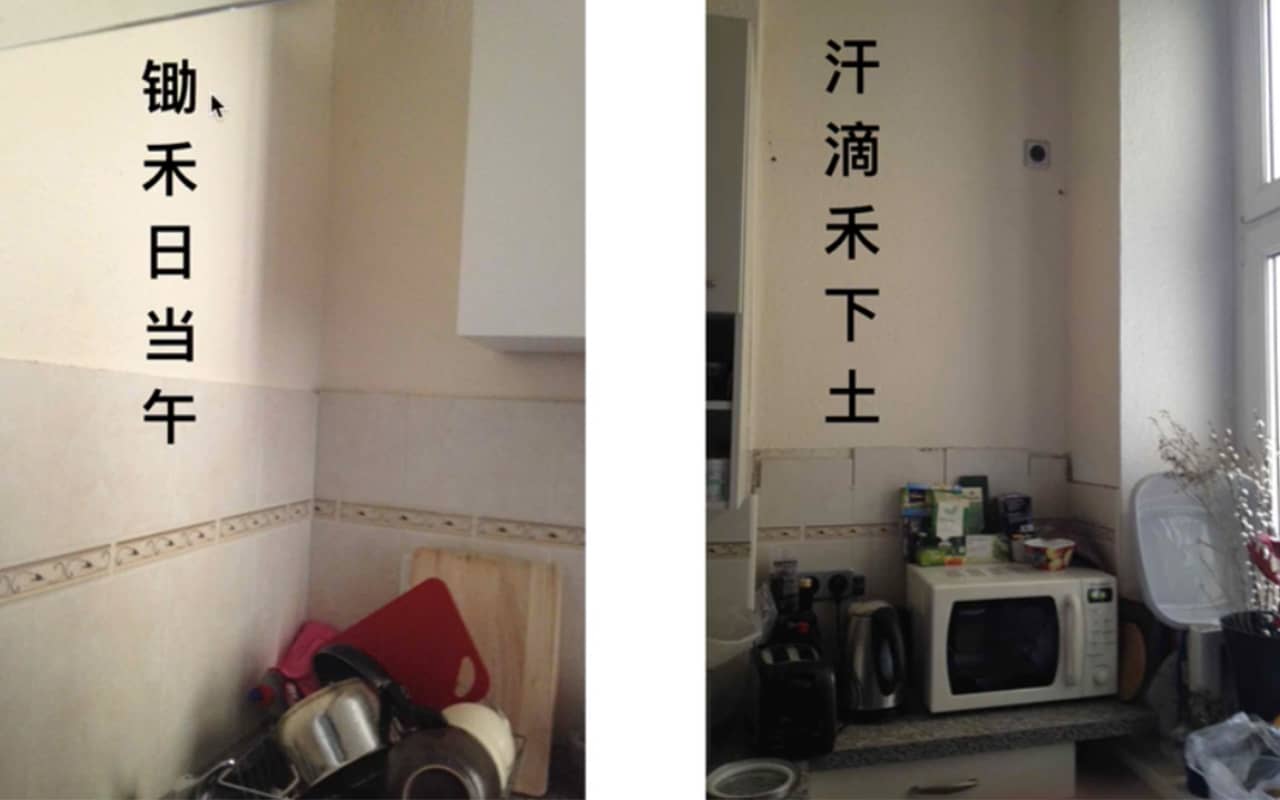
With practice you can transform every home and building you’re familiar with into Memory Palaces that help you rapidly memorize all the Chinese vocabulary and phrases you create time for.
The next step is to use the Memory Palace for “Recall Rehearsal.” Remember when I told you in the beginning about reducing the amount of repetition when getting Chinese into long term memory?
The Memory Palace technique is how. Basically, you use the Memory Palace to harness a few aspects of memory called:
- Primacy Effect
- Recency Effect
- Serial Positioning Effect
- Von Restorff Effect
The way to get really good at this powerful memory approach is to have a strong Memory Palace training routine. That way, you can get to the point where you memorize entire lines of Chinese within minutes, sometimes seconds. I demonstrated this skill live with Chinese lyrics on this live stream:
For a more detailed example, take the song The Moon Represents My Heart. This wonderful piece of Chinese music goes by this name in Mandarin:
月亮代表我的心 (Yuè liang dài biǎo wǒ de xīn)
The title recurs through the song, so I created one image per word and placed each in a Memory Palace. For example, for Yuè liang dài, I saw a ewe wearing Lee jeans that were just a bit too long while doing magic with a die. For biǎo wǒ de xīn I saw a bee stinging David Yow (the singer from a band called The Jesus Lizard). For de and xīn I imagined a French Canadian kicking David Yow in the shin.
Here are more mnemonic examples for Chinese:
To get everything into long term memory quickly, I harnessed the effects of memory I just mentioned by exaggerating all of the mental associations and then following the Memory Palace journey according to a small number of patterns. I cover everything in greater detail in Memory Palace Mastery:
How should you gather and organize your words and phrases for placing in your Memory Palaces?
I suggest making it easy on yourself in the beginning. Memorize exactly what you learn in the program and book you chose.
This is yet another reason to choose well and go through your resources thoroughly. I did this with Pimsleur and learned a lot of basic Chinese very quickly just by listening to the program, writing out the pinyin by hand and them memorizing each line in a Memory Palace:
Likewise, when you record your sessions with Chinese teachers, you are essentially giving yourself a program to extract information from and memorize. And because you are working based on missions, you’ll proceed very quickly and in a way that is better than any course or book on its own can provide.
Step Eight: Learn The Tones And Practice Sounding Them Out
Learning the tones is really important. I suggest you learn mnemonics first, however, including a technique called the Major Method. This mnemonic device lets you add a secondary image.
There are four tones, though you will sometimes find people saying there are five or even six of them. To my ear, there are only four and most people seem to work with that number.
As with pinyin, you’ll see the tones represented in different ways. For example, you might see:
- mā or ma1 (first tone)
- lé or le2 (second tone)
- kǒng or kong3 (third tone)
- yù or yu4 (fourth tone)
A simple way to memorize the symbols added above the letters is with a friend or animal. For example:
- mā (imagine a kangaroo punching straight forward)
- lé (imagine a kangaroo jumping up)
- kǒng (imagine a kangaroo hitting the ground hard enough to dent it)
- yù (imagine a kangaroo breaking a board in two)
Now, you’ll rarely see single syllable words as in the examples above outside of textbooks. Usually Chinese words come in syllabic pairs. For example:
很好 (hén hǎo or hen2 hao3)
When you use the Major Method, you can instantly create an image for 2-digit numbers. So if you’re memorized 很好 (hén hǎo) and want to remember the correct tones, you can think of your image for 23.
If the core image for the word is a hen asking a garden hoe how to use it, then the image to remind you that you need to use tones 2 and 3 would be something like a Vietnam vet. This works because 2 is always connected with an ‘n’ and 3 is always associated with an ‘m.’
Sound too complex? Maybe in the beginning it will be, but it’s an incredibly powerful tool if you devote yourself to learning it. And since there are tones to learn for each and every word in Chinese, I recommend that you do.
Again, if you’re following along so far, you’re going to have plenty of speaking opportunities and you’ll have recordings of yourself speaking with your teacher. Listening back to your own voice can be a painful experience, but soon you’ll get used to it and develop critical distance. Listening objectively and comparing your voice to native speakers will help you correct.
Step Nine: Learn Chinese Characters
I was given the advice to focus mostly on pinyin and oral Chinese for at least a year. Although I like drawing and did a small amount of work with my character book (which I mostly used for the word list in the back), I mostly followed this advice.
Why delay the writing system for so long?
Well, the advice isn’t going to be right for everyone, but let’s face it. When learning Chinese, we’re asking the brain to handle a TON of information:
- Characters
- Tones and tone shifts
- Core sounds for words and phrases
- Meanings
- Grammar
When exactly the time comes to add Chinese characters is up to you. There is no perfect time. But I do think it makes sense to delay it so you can focus just on pinyin and sounds to gain a solid footing and start recognizing the Chinese you hear.
When it comes time to memorize the characters, you’ll need to consider learning stroke order. This can be done using a Memory Palace by imagining the stroke order on imaginary walls.
For example, you can have two rooms in a Memory Palace and on seven of the walls, place mental associations that help you remember:
- Characters are generally constructed top to bottom
- Left to right when radicals are in play
- Horizontal first, vertical second
- Close the frames before filling them
- Close the frames last
- Anytime a line spans the entire character, draw it last
Personally, I just do my best and practice improving over time. Remember: Focus on missions. If you’re never going to write, maybe you should choose to focus purely on reading characters instead.
This is where Pleco with the Outlier Linguistics add-on is great because it will show you the early origins of the characters, which are often filled with pictorial clues that help build your recall even without mnemonics.
Drawing to learn Chinese Characters
Sometimes I don’t feel like using mnemonics – at least not right away. That’s why I draw the images sometimes.
In this case, I made a simple drawing of the red band on a slingshot, a gong and some sheep going to work to remember the word for office in Mandarin: 办公室 (bàn gōng shì). Later I transported this image into a Memory Palace with other words for Recall Rehearsal.
Mind mapping to learn Chinese Characters
You can also use Mind Mapping to learn Chinese. I do this with tougher characters, or to create variety as I learn. It helps me stack on more mnemonics faster and in a way that includes more information about the sound, meaning, tones and characters.
This method takes a bit more time in the beginning, but the more you practice, the faster you’ll get.
In the example above, you can see how I’ve used the Major Method to remember the tones and “laddering” by incorporating some German. If you know multiple memory techniques and languages, use them!
Step Ten: How to Study Chinese By Balancing the Challenge-Frustration Curve
As you proceed along your Chinese learning journey, you’re going to find that some things get easier. When that happens, you’ll do yourself little or no good by repeating things that no longer challenge you.
The flip side of the coin is that you don’t want to get ambitious and skip so far ahead that you frustrate yourself. That just leads to giving up, or taking unusually long pauses. (As you’ll see, taking some breaks are actually good, but not for too long.)
Since everyone’s journey is different, there is no perfect example. But let’s say that you’ve gotten good at ordering your favorite foods at a restaurant. You can make things more challenging by talking about world events.
But if you find that is too challenging, scale back. Talk about what you did yesterday instead and pepper in learning a few words about watching the news as you gradually build up to talking about its content.
Step Eleven: Meet With Native Speakers As Often As Possible With Missions
Although the Internet has allowed us to meet Chinese native speakers and teachers from around the world, the miracle of technology does have some deficits. You don’t have the full benefit of proxemics, for example, which is the full range of gestures and hearing sounds unmediated by technology.
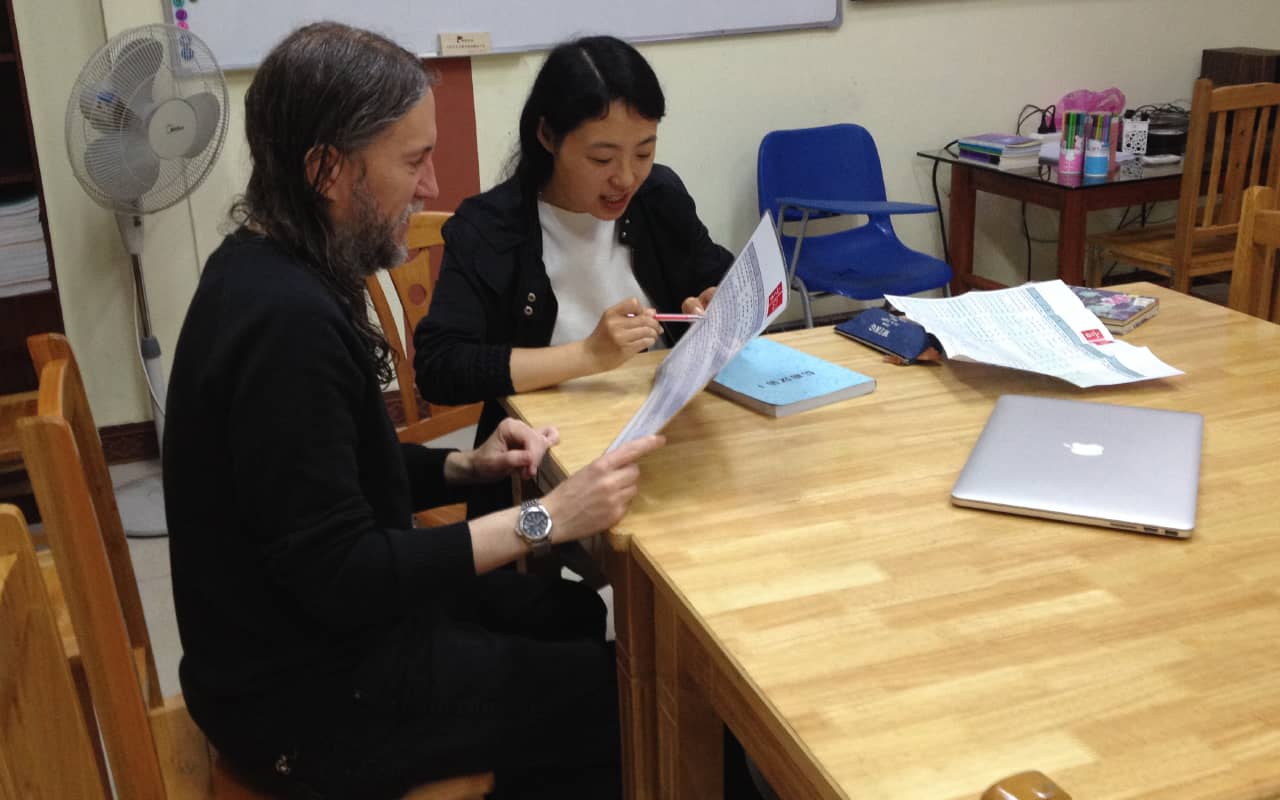
A great way to learn faster with a native speaker is to sit at a table and discuss the pictures in a magazine. By this time, you should know some phrases like, “What’s this called?” You don’t have to make your first conversation any fancier than that. Just sit with your native speaker and keep asking the question, listening to what they say.
You can do a version of this online with scans from magazines you bring to your learning lessons, but there’s something magical about sitting with a native speaker whenever you can. Do this as often as possible.
Step Twelve: Stack On More Resources With The Same Focusing Rules
The temptation to sign up for more courses will be ongoing. Eventually you should, taking care to schedule out your study sessions and complete each from beginning to end. Here are some of my favorites that I’ve completed:
- Pimsleur Mandarin
- MandarinHQ (my preferred course)
- Outlier Linguistics
- Mandarin Corner
I also learn a ton from Instagram teachers like:
Each of these teachers makes it fun and easy to hear and read Chinese every single day. But don’t forget to write out what you learn, speak it yourself and memorize the information using the Big Five. Language learning requires tons of input, but you’ve also got to add output in order to learn.
Step Thirteen: Take A Formal Class (Optional)
This step is not strictly necessary, but I’m glad that I registered for a course with the Confucius Institute in Brisbane. It was my first in-person class.
They started with an intake test and I was surprised and delighted when they fast tracked me to level III based on the skills I showed up with based purely on the self-study tips you’ve learned today.
What I loved about the course includes:
- Very small class size
- The teacher used English only as a last resort
- Characters were used with a minimum of pinyin
- It made the discipline of sticking with one textbook easier
- It was fun to use the class itself as a Memory Palace
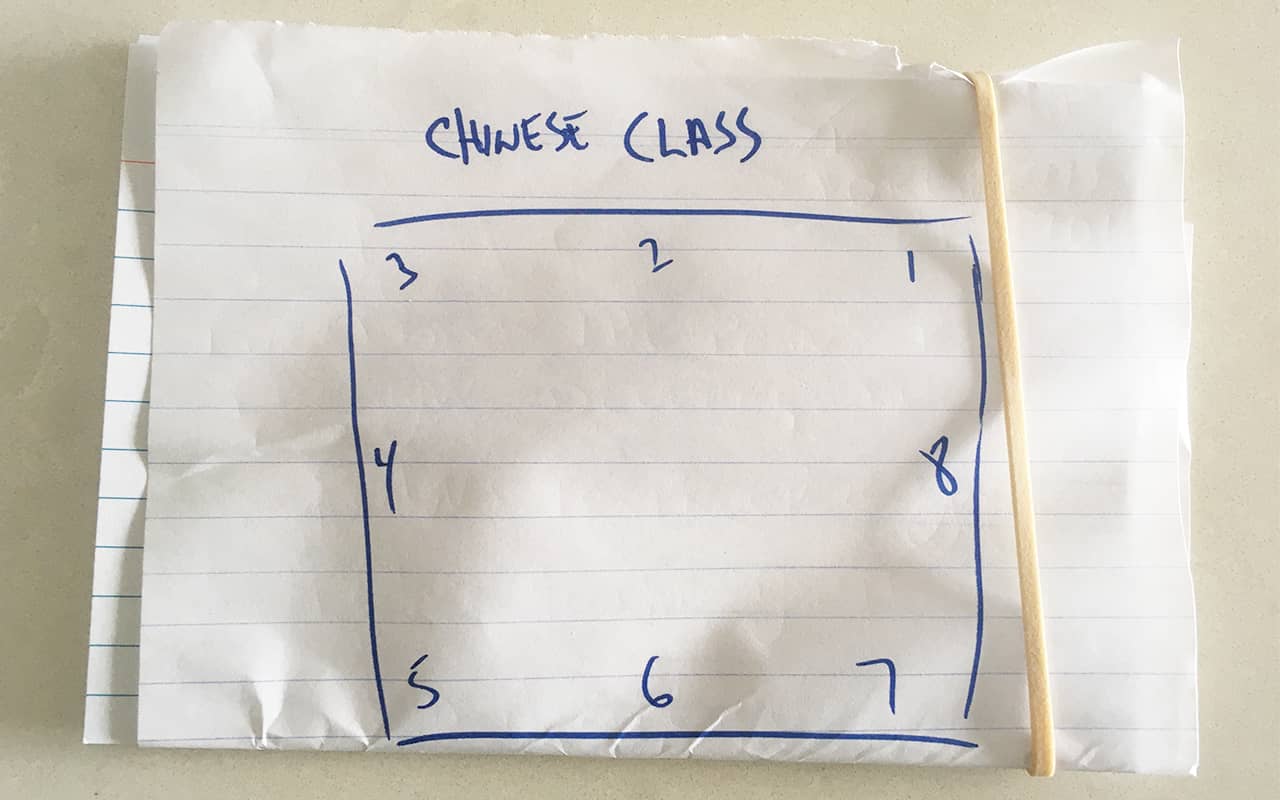
The only thing I didn’t like is that the classes took place at night. Other than that, it really helped accelerate my Chinese abilities, though I’m very glad that I waited to take the course and studied on my own in the beginning.
Step Fourteen: Talk To Yourself – Often
When learning Chinese, you want to develop the habit of “self talk” in the language.
For example, when you’re planning your day, do it in Chinese. If you find that you don’t know the word for post office or certain grocery items, now you have a mini-mission.
This habit starts small in the beginning when you only have a few words. But start doing it anyway. It’s a form of active recall and it helps you keep track of where you have holes in your fluency. If you don’t do this kind of self-talk in Chinese, you lose out on a lot of self-analysis that helps you craft better Chinese learning missions.
Step Fifteen: Take Strategic Breaks
Believe it or not, it’s a good thing to take a week off from time to time. There’s no specific pattern to follow, but let’s say that a good rule of thumb is 5 weeks on, 1 week off.
The trick is in scheduling these breaks so that they’re not random or accidental and you have a path for getting yourself back on the horse.
Taking breaks works because they allow your brain to percolate the information you’ve focused so hard on absorbing. This effect is sometimes called diffuse thinking.
You can also get it by taking ample breaks during your study phases. For example, rather than cramming for an hour, you might find you learn and retain more when you work in fifteen minute blasts. Explore different patterns and journal what works for you so you can see and make use of the trends that emerge.
More Power Tips And Troubleshooting Advice For Learning Chinese
You’re probably going to have tons of questions along the way. My suggestion is to try to answer your own questions as much as possible and keep yourself focused on getting as much input as possible while writing and speaking the language from memory.
Beyond that, here are some common questions:
How long will it take to learn Chinese?
I doubt there’s a one-size-fits-all answer. If you’re mission oriented, you should be able to have simple, and yet highly useful conversations within three months. Again, base everything on your missions and you’ll always be satisfied with your progress, provided you’re focused on fewer learning materials you use thoroughly.
Also, it’s important to think deeply about what “fluency” means to you – not what it means in the dictionary or in the mind of some language learning showoff.
In my books, the definition of fluency is simple: It is the ability to be understood and understand or find a way to understand what people say to you.
This particular definition is important because if you think about it, that’s exactly how you are fluent in your mother tongue. People misunderstand us all the time and we misunderstand others. But we are fluent because we know how to give or receive clarification. It really is that simple, and focusing on missions will get you there quickly.
Should I travel to learn Chinese?
I certainly benefited a great deal by visiting China – but the bulk of my Chinese study has taken place in either Germany or Australia. Most polyglots agree that short term travel is typically one of the worst ways to learn a language because you’re so focused on seeing the sights and enjoying yourself.
Plus, native speakers you meet on the street or everyday people with lives – not language teachers. Sometimes you’ll luck out and meet people interested in helping you learn, but that is not a strategy and no way to complete the kind of missions we’ve talked about today.
What time of day should I study Chinese?
The answer to this question requires some self-analysis. Some people do really well in the mornings, others do better in the afternoon or evenings.
Personally, I’m a morning person and I used to keep my Chinese character book next to my bed so I would not forget to get my main blast of studying done right away.
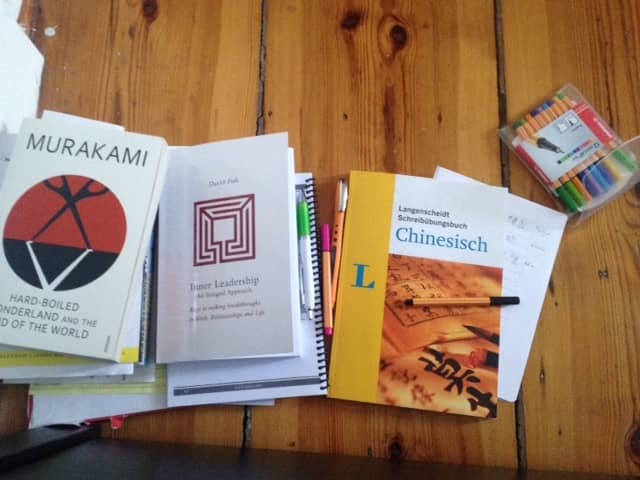
Where can I learn Chinese near me?
I would suggest searching Google with a command like:
intitle: chinese class + name of your city
A command like that can really help narrow things down. You can also search Meetup for information groups, and keep your eyes peeled for bulletin boards around your local grocery store. I see advertisements from Chinese tutors near mine all the time.
What about software for learning Chinese?
As with any program, it’s great to experiment, but only worth going through if you’re thorough – and even then.
Without naming any names, so many softwares give you phrases in lessons that help your brain confuse activity with accomplishment. Plus, if you’re using free versions, they are loaded with ads that interrupt your progress.
Rosetta Stone is one of the most developed softwares, but you’re thrown in the deep end from the beginning and have to guess what words and phrases mean by looking at pictures (which are excruciatingly small on mobile). This process is not as interactive as it seems and you spend more time deciphering a puzzle than committing Chinese to memory. And although the software prompts you to speak, I’ve tested it and as far as I can tell, it is definitely not testing for accuracy.
What movies should I watch to learn Chinese?
Watching movies is a good idea, and there are countless options. Yoyo Chinese gives a few Chinese language movie options that are freely available on YouTube.
However, aspects to consider are the naturalness of speech and likelihood of encountering words and phrases that relate to your missions and what you want to say in the real world.
I suggest documentaries on topics that relate to your learning missions. With these Chinese documentary suggestions, you can readily find natural speech examples to learn from related to real life missions you might actually want to accomplish.
Conclusion: How To Craft The Best Way To Learn Chinese
Learning a language like Chinese isn’t that much different than any other. You just need to set some rules and then practice consistently.
Remember how I told you my mentor Tony Buzan said the rules will set you free?
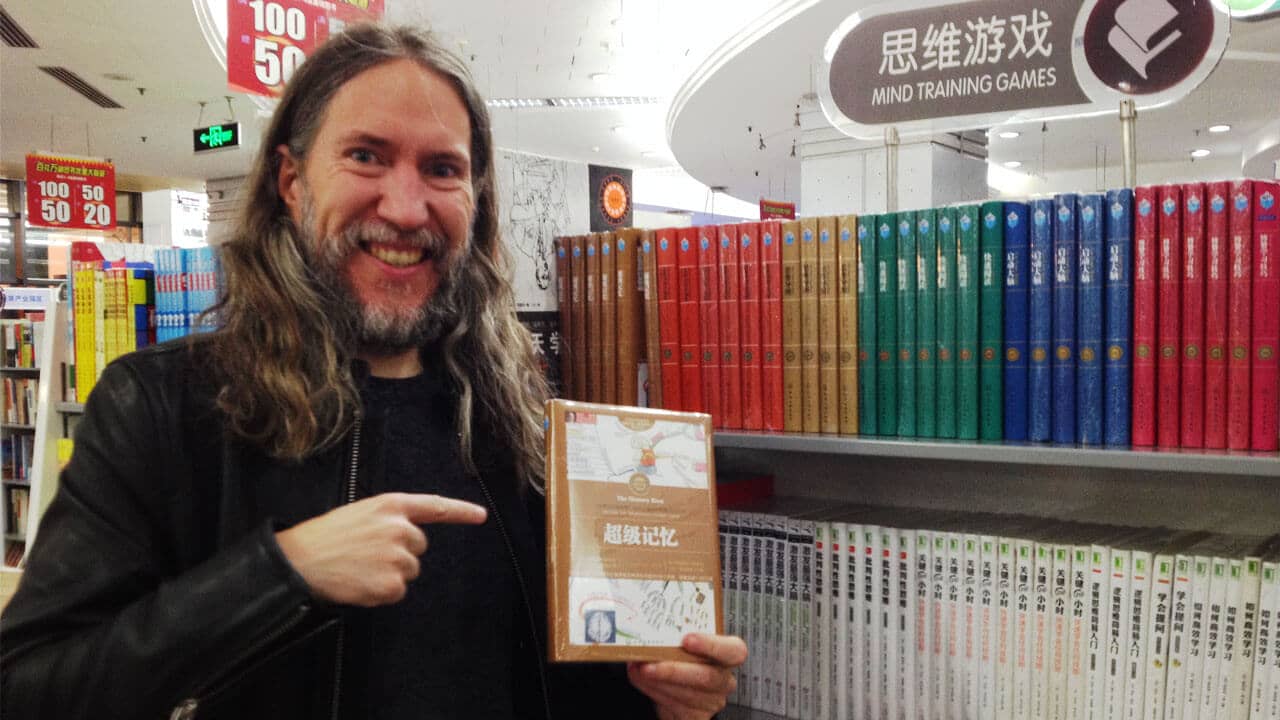
Tony said that to me when I saw him just before taking my first trip to China. I’ve thought a lot about what being “free” to learn faster and remember more really means. Here’s what I’ve come up with:
Frequent practice in a state of…
Relaxation and a spirit of…
Experimentation within well defined limits will keep you endlessly…
Entertained
Follow the rules in this article and you’ll be “free” to speak Chinese as fluently as you wish in no time at all.
And if you need more help, check out this special free course I put together so you can learn more about the mnemonics that helped me pass my Chinese test in a flash:
Related Posts
- How To Remember The States: A Step-By-Step Guide
Learning how to remember the states is fun and easy. Here are three powerful ways…
- How to Memorize Vocabulary: A Step-By-Step Guide
If you want to know how to memorize vocabulary quickly and permanently, this step-by-step guide…
- Best Languages to Learn for Business: Everything You Need to Know
What are the top business languages that will help you in your climb to the…

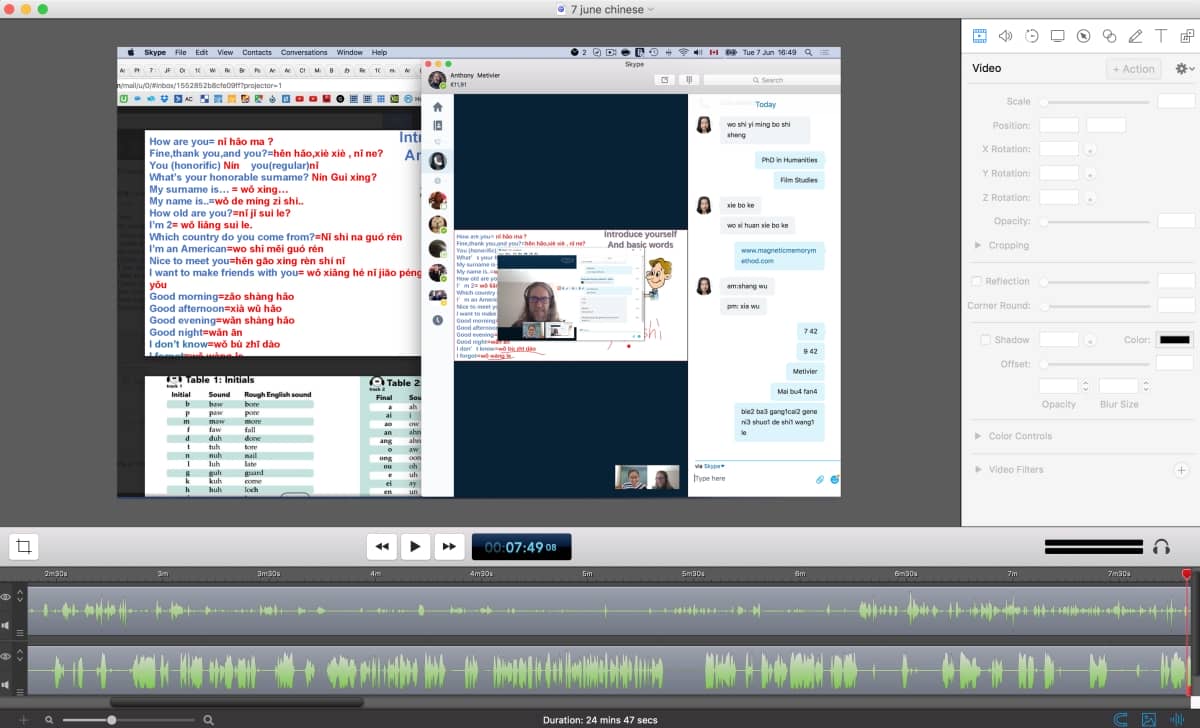

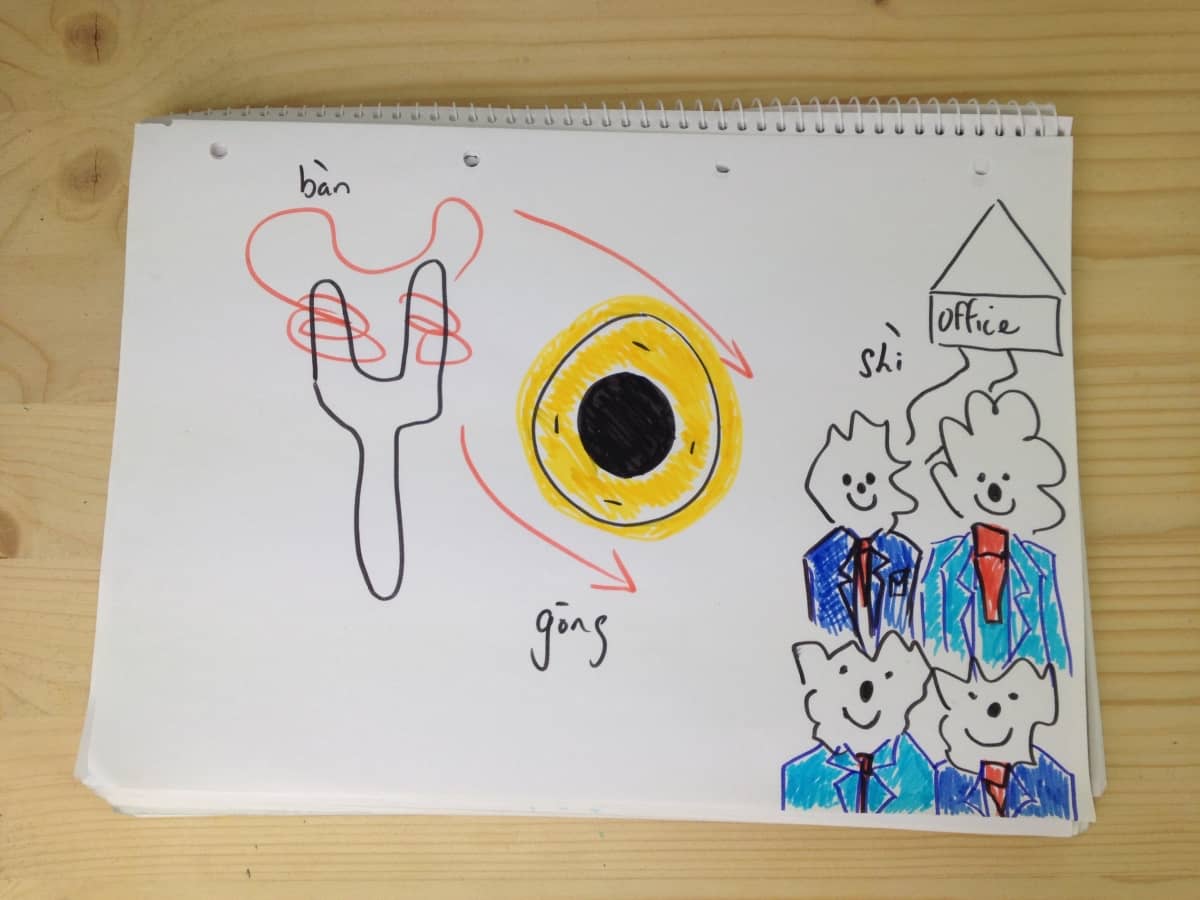
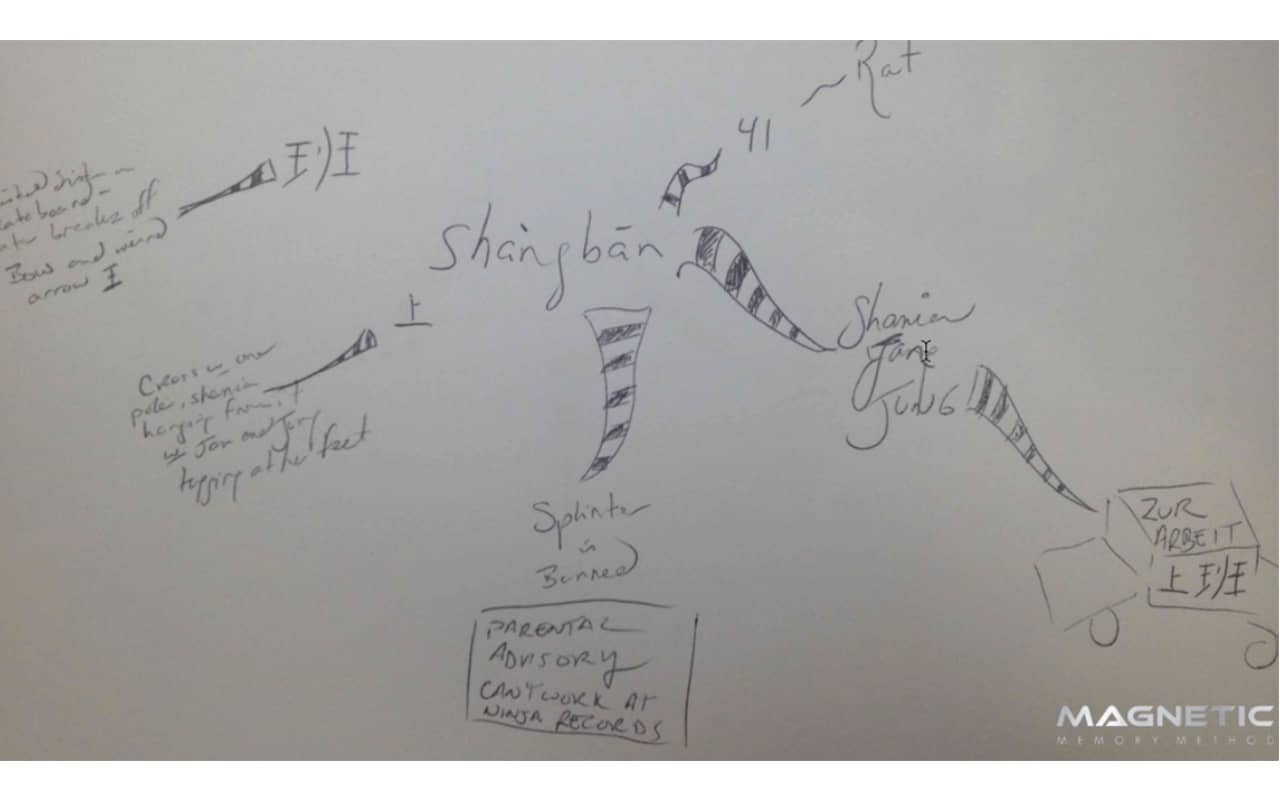
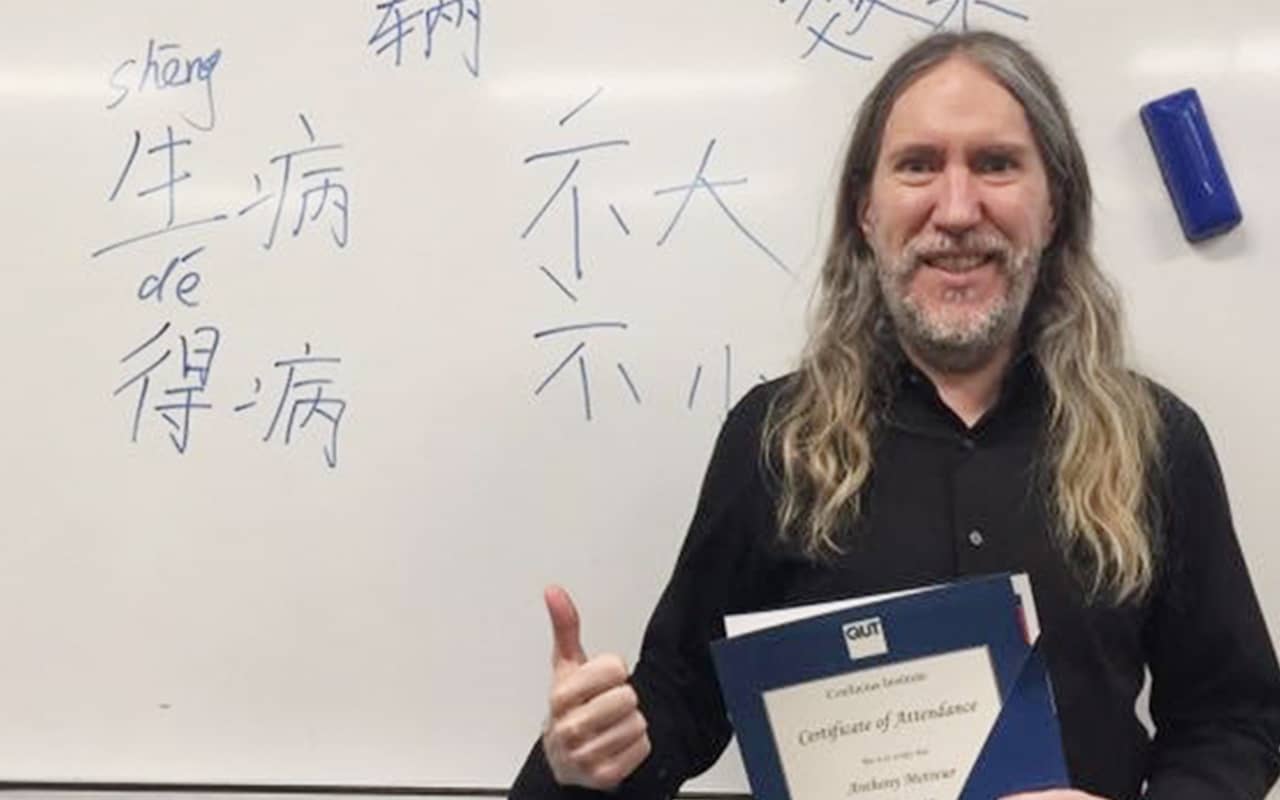




33 Responses
Good post. No, a very good post. I am doing something similar and it brings good results. My basis for memorizing the characters is “Täglich Chinesisch” — http://tinyurl.com/taeglich2
Thank you for all your good work, Anthony!
Thanks for your comment and kind words, Herbert. I’m also grateful for the link you’ve shared. What an awesome resource! 🙂
You’re doing too much writing. Only write if you’re either actively working on handwriting or if you get the character wrong.
You’ve slipped into rote memorization. Just memorize the components and you’ll know how to write.
Thanks for your comment, Ted.
As you suggest, one should repeat only to refine the handwriting and this is my task at the moment. Although I haven’t exactly cracked the code on how to memorize the characters themselves, as you can imagine, I’m not going to turn down the side-effect of recalling them thanks to the repetitive writing.
But I’m curious: do you think that repeated writing falls under the category of rote learning? For example, I’ve studied drawing for quite some time and have put in a lot of time creating circles and squares. I’ve never thought of this as “rote drawing,” though I suppose it is. I’m very curious about your thoughts on this because there certainly are parallels. 🙂
Anthony
Learning to write Hanzi is a pure memory exercise. There is some logic but very little. It is considerably easier to learn to write Chinese when one already has a basic vocabulary learnt using pinyin.
In China, they are seeing a trend of Chinese people forgetting how to write Chinese because they are all using their computers and cell phones to text using pinyin. They input pinyin and the machines translate to Chinese characters.
Thanks for your comment, Alexander.
I think overall, you’re right that the characters require hard memory.
That said, I’ve already been using mnemonics to remember some characters to aid in the writing process. 六 I saw as a leaping leopard, 八 as a two-legged octopus-sheep saying “baa” and 七 is an upside-down 7 smothered in cheese.
For other words, 手 isn’t so hard to see as a six-fingered hand, even when squished to the side. 心 is a heart with three hooks pulling it apart. (Yes, I watched too many Hellraiser movies as a kid!) 不要 is a broom smacking a woman with a basket on her head.
This is not a 100% solution and doesn’t necessarily help with stroke order or memorizing sound – which is what I work on first in line with your suggestion. At the end of the day, it is a combination of methods and I would never leave mnemonics out of the equation at some level.
About the technology, how sad that people would forget how to write this beautiful script in favor of tapping screens. I was speaking with someone the other day who could not believe that I prefer an old spring-loaded keyboard to my Mac chiclet keys. But the reality is that I write better when using it. Many authors and singers still compose on old typewriters, simply because the technology helps focus their concentration better. And yes, some people even write entire books by hand. Whatever gets the job done and helps them contribute value at the highest possible level is awesome and should not be judged.
Anyhow, change is the only constant in the world and who knows what new forms of thinking will emerge – if any – from a world lost in screens.
Learning using mnemonics as suggested above is extremely useful, and most importantly, much more fun than rote memorization. If you have more fun doing it then you will do it more often and more thoroughly. I’ve had a lot of success using little stories for remembering the Japanese kanji and now that I live in China I’m doing the same for Chinese Hanzi.
Stories are very useful indeed. Thanks for sharing your experience! 🙂
Anthony, back when I was in the military and had to be in great shape and had to take periodic physical fitness tests of running, pushups, and situps. If I was going to work out first thing the next morning, I would leave my exercise t-shirt, shorts, and running shoes right at the side of my bed that evening so that as soon as my feet hit the ground in the morning I was almost stepping on this outfit. Almost always I would put on the outfit and go workout. This is the same concept you are doing with your learning resources. It’s a great productivity hack and I can attest that it helps tremendously to get a person accomplishing the important things as early as possible in the day.
Thanks for this contribution, Francisco. It’s great when we can make accomplishing our dreams the foundation of each morning. It really makes the rest of the day more enjoyable and profound.
Anthony,
I really enjoyed this article and podcast episode! I like your idea of doing my language learning first thing in the morning. I want to learn a new language and have decided to learn German. I plan on using your 3 system method. Would you recommend using the Pimsleur program for German?
I’m going to buy your book “How to Learn and Memorize German Vocabulary:Second Edition.” I know you have studied the German language for many years. Would you recommend any other books or resources?
I’d also like to find a language teacher in German because it’s like you said you really can’t learn a language without speaking it. How did you find your language teacher for Mandarin?
I have never mediated before, but I’d like to start doing it daily. I think it will benefit me in many areas of my life. I’ll have to check out the Human Charger. It sounds pretty cool and it sounds like you are enjoying it!
I’m going to take your advice and cut back on my Facebook use. Facebook is nice to keep up with family and friends, but it can become addicting. I know I waste time on it each day that I could spending doing more productive things.
Once again thanks for all your great advice! I have found your website and podcast to be very informative and helpful!
Thanks for stopping by and commenting, Chris!
I haven’t gone through Pimsleur German, so I can’t comment on its quality. A lot of people recommend Assimil language trainings, but I also haven’t tried anything from them for German. I’ve looked at the Mandarin training, however, but decided to go with Pimsleur for this memory experiment due to the accessibility to Pimsleur’s research behind why the programs are setup in their particular way. He talks about his approach in How to Learn a Foreign Language.
Here’s the important thing:
Whatever program you invest in, go all the way through it. Many people (including me in the past) make the classic mistake of starting with one language learning training and then stopping. Then they pick up another. It’s almost as if we believe that “the next one” will magically be the training that we finally stick with and get results from.
The truth, however, is that we work the program more than the program works us. Of course, there are occasions when we just don’t gel with the style of something, so it’s important to make sure you have a guarantee in case you really need to return something. But I think with something like Pimsleur, you’ll probably be good to go, so if you get it, go all the way through with it.
One German product that I started with years ago, but abandoned, was the Michel Thomas training. In principal, I like listening to him, but I’m not convinced that the way he interacts with students and the regular beeping really helps. I certainly can’t see it working with for the memory program I’ve suggested in this post. He also says weird things like that there are no bad students, only bad teachers. Clearly, as I’m suggesting in this post, there are both, and the teacher and student need to meet each other halfway.
Anyhow, check out Michel Thomas for yourself. Like Pimsleur, he had an interesting idea in mind and certainly helped a lot of people. There’s a book about his life and work that I’ve been meaning to read by Wyatt Woodsmall called The Future of Learning: Freeing Minds One Person At A Time.
It’s great that you’re going to read How to Learn and Memorize German Vocabulary. The Second Edition isn’t definitely the one to go for. You can find its origin story on the podcast too.
About getting speaking partners, I use italki. It’s a really great service for linking learners with teachers.
Definitely get into meditation. Here’s a quick podcast tutorial on How To Improve Concentration And Memory Buddha-Style that goes deeper into the topic. I think you’ll dig it.
Thanks again for your comment. It means the world to me and I hope you’ll keep coming back to the site for more discussions like these! 🙂
For the transliteration part you might want to try Siri. Set her to English then sound your foreign word or phrase she will make a best to guess to what it sounds like in English. Then use homophonic guess for your mnemonic.
Btw does anyone have a good mnemonic for spelling “mnemonic”?
Wow, thanks for this suggestion! I haven’t played around with Siri much, but I will give it a try during the hours such tech is allowed in my daily program. 😉
To remember “mnemonic,” the first thing that pops to mind: Nemo (from Finding Nemo) bashing Nic Cage on the head with a giant letter ‘M.’ That might do the trick for those familiar with the pop culture references. But the best mnemonics are always the ones that we come up with ourselves. I do not believe there are any truly “good” mnemonics apart from that, though this is a long and interesting discussion that we had during a Q&A following the memory training I gave in Guilin, China. I might be getting dogmatic in my old age …
Thanks again for the great suggestion!
Hi Anthony and thank you for this interesting and helpful blog posting.
I’ve just started to learn Chinese (with Pimsleur) I was trapped by the same nails in my head you mentioned above. I wanted to smooth my learning way and reached out for some help. Found your “How to Learn and Memorize the Vocabulary” course (okay, started yesterday, now at lesson 25).
As a native German, or maybe as a native bloke-head, I run into some problems with the Chinese vowels. How can I memorize these very special nouns and sounds into a mnemonic?
If I take the example “teacher” (“Lehrer” in German) 老师, I would transliterate it as German into “Lao Schöh”. But how the heck can I compose a mnemonic having something like “Lao” and “Schöh” inside? Combined with the meaning of a teacher? I mean “Schöh” is more easy, because the adjective “schön” (pretty) is fine for this purpose. But “Lao”? Taking the country Laos? I will not remember Laos?
Ah moment, perhaps I’ll take the “Lao-La”-Wave.
What about that: A bright (“schö”ner) summer day in front of the school. A teacher (“Lehrer) dances the “Lao”-la-wave.
Is that the way you think of these combinations? How shall I sort that into a Memory Palace?
Thanks for this great post, Georg!
You’re definitely on the right track, so keep exploring the sound/meaning pairings you’re working with.
For me, the Lao of 老师 is easily covered by the philospher Lao-tze, as as it is sometimes spelled, Lao-tsu. The real trick is in taking the time to discover a large number of words with the “lao” sound so that you can follow that figure around a Memory Palace journey. When you use the Bridging Figure principle as taught in the vocabulary course, you get way more milage out of your mnemonic efforts.
That way, even if it takes a while to come up with a solution for front-end sounds like “lao,” you’re able to exploit it for a number of words instead of having to reinvent the wheel again and again. To give another quick example, 别 or “bie” is simply represented by a bumble bee and I follow that little fellow all over the place in one Memory Palace loaded with “B” words. This Memory Palace also includes “ban,” “boa” and “bei” words, amongst others. The Bridging Figure technique is a huge part of the Magnetic Memory Method and not to be missed.
Other than that, it’s all just a matter of practice. The more you use the technique, the better, faster and more certain you get at it.
I hope this helps and look forward to an update about your progress! 🙂
Marvellous Anthony for coming back on my comment. Haven’t expected that quick response. What a nice surprise in the morning.
For sure I’ll follow your advice and look out carefully for the bridging words.
Sounds good. Stop by again with an update or more questions anytime. 再见! 🙂
Great post Anthony.
What do you think about “The Marilyn Method for memorizing the pronunciation of Chinese”?
Google it and it will be the first result.
Hi JK,
Thanks for posting about the Marilyn Method.
Alex Mullen and I talked about it when he appeared on this episode of the Magnetic Memory Method Podcast.
At that time, Alex seemed to be making great use of it. He and I are scheduled to speak further on the matter in the fall, but I think you’ll really enjoy his thoughts on that episode.
For myself, I’m using a different approach at the moment, one that allows for the memorization of pronunciation and meaning at the same time. I’ve always done this with vocabulary memorization, but here the trick is not just pronunciation and meaning, but also knowledge of the specific tones.
To solve that, I just brought my card memorization images together with the standard Magnetic Memory Method principles for memorizing vocabulary en masse. It works a charm.
The coolest thing is that you can then go back over the Memory Palace journey and in many cases, find ways to layer on or integrate imagery that will help you memorize the characters as well. This isn’t always the case, but for simple ones, it’s very effective.
That’s the status quo now. Keep listening to the podcast for more details going forward. In the meantime, I’ve tried before to get in touch with the author of Country of the Blind to interview him about his mnmemonic approach to Chinese pronunciation, but cannot find a means of contact apart from posting on his thread. If you’re ever in touch with him, please let him know that I’d love to have him on the show! 🙂
I’m the creator of the Marilyn method. I’d be happy to chat with you.
That would be great – let’s record something about it sometime soon!
Wow, Anthony, I had no idea you had published this new tract on learning Mandarin, which Ive been doing intensively for the last month on the Rocket Language website after ending up there after a year long of pursuing every lead for learning German, including you article and book.
I just mentioned you and your techniques in the Members Forum there in a short article-blog I wrote about the research that has just been reported that drawing pictures of words doubles word memorization performance.
I sent it to you elsewhere but it would fit right in this blog here.
New Memory Research shows drawing pictures doubles recall performance for memorizing words.
David K
——————————————-
I’ve been fascinated by techniques for enhancing memory in language learning and thought this latest research, just published in the latest issue of The Quarterly Journal of Experimental Psychology, might be interesting to students here – especially the Chinese languages students. Here are links to both a short topical report in the Huffington Post, as well as link to the original publication.
http://www.huffingtonpost.com/entry/drawing-memory-study-jeffey-wammes_us_57bb1648e4b0b51733a48c35?section=&
Then, all students were made to perform a “filler task” to distract them from the previous exercise. Afterwards, they were asked without warning to recall as many of the 40 words as possible. Those who drew them remembered over twice as many as those who wrote them.
To hammer the results home, Wammes conducted a series of secondary experiments, inviting students to partake in similar memory-related tasks ― like looking at pictures of objects, creating mental images of objects, listing physical characteristics of objects, writing words with visual details. Those who drew pictures of the words still remembered more than those who participated in the secondary strategies.
http://www.tandfonline.com/doi/abs/10.1080/17470218.2015.1094494?journalCode=pqje20
Journal
The Quarterly Journal of Experimental Psychology
Volume 69, 2016 – Issue 9
Abstract
In 7 free-recall experiments, the benefit of creating drawings of to-be-remembered information relative to writing was examined as a mnemonic strategy. In Experiments 1 and 2, participants were presented with a list of words and were asked to either draw or write out each. Drawn words were better recalled than written.
Experiments 3–5 showed that the memory boost provided by drawing could not be explained by elaborative encoding (deep level of processing, LoP), visual imagery, or picture superiority, respectively. In Experiment 6, we explored potential limitations of the drawing effect, by reducing encoding time and increasing list length. Drawing, relative to writing, still benefited memory despite these constraints. In Experiment 7, the drawing effect was significant even when encoding trial types were compared in pure lists between participants, inconsistent with a distinctiveness account.
Together these experiments indicate that drawing enhances memory relative to writing, across settings, instructions, and alternate encoding strategies, both within- and between-participants, and that a deep LoP, visual imagery, or picture superiority, alone or collectively, are not sufficient to explain the observed effect. We propose that drawing improves memory by encouraging a seamless integration of semantic, visual, and motor aspects of a memory trace.
Modern Chinese characters have evolved through many stages, but if one goes back to “oracle bone” inscriptions circa 1400 BCE many of the original “logograms” were pictures.
This research is consistent with many of the memory techniques I’ve been practicing and reading about. I just bought a book called “Chineasy” by Shaolan in which she offer pictures to help remember 400 basic characters, about 140 of which are component building blocks used to compose more complicated characters.
I was having a difficult time remembering the genders of the German nouns used to determine the definite and indefinite articles. A fellow named Anthony Metivier has written several papers and offers workshop on memory methods for learning languages suggested using colorful and wild images and Memory Palaces for remembering vocabulary and including in the image a boxer or masculine symbol in the image for masculine nouns, a ballerina for feminine, etc. So I tried out using Mohamed Ali, a Ballerina, and an image Farinelli, the famous castrati for neuter. I was astonished at how well that works.
Does anyone else have memory enhancing techniques they use to accelerate learning?
David
Thanks for this, David. I really appreciate you taking the time to comment over in Rocket Language and repost here. That’s great!
Yes, drawing is a very effective way to remember information. You’ll see that more and more I’ve been including drawings on the site, such as on this post about remembering names at events. There’s a drawing for a Chinese word here as well too.
I think Chineasy is a good book, but like so many books on mnemonics, it is example-based. What we need are more principle-based trainings so that we’re teaching people to fish. The core of the research that you’ve mentioned is that people are doing their own drawings. Looking at what someone else does risks trying to make their outcomes work for you, when in reality, Shaolan (I assume) already knows Chinese. What would be more helpful for serious language learners interested in mnemonics is learning the principles that underlay memory techniques and then finding the encouragement to practice them as a way of life.
Maybe I’m getting more and more old-fashioned, but I’ve seen thousands of people getting extraordinary results based on principles compared to middling results based on mnemonic books grounded on examples.
I look forward to any further thoughts you have on this important pedagogical matter and thank you again for your time and thinking. It’s impressive and inspiring! 🙂
I use memory palaces for learning Chinese characters.
Creating images for them (character structure, pronunciation, tone, meaning) is tedious but not so difficult.
The problem I have is: I don’t really know WHERE to store them BEST in the palaces.
I read your book “Learning German vocab …” and you recommend to store items according to alphabet A-Z and then just in a sequence in rooms of the A or B, etc-building.
But with Chinese it’s quite different.
You can store them according to radicals (all mouth-, tree-, heart- etc. characters in a mouth, tree, etc-building) (–> easy access when you see a character).
Or you can store them acc. to Pinyin pronunciation ai, an ba, da, dang, deng, etc. (easy access when you hear something).
Do you have any recommendations or tips for this problem?
Thanks in advance for an answer and thank you for your great blog, podcasts and products.
Thanks so much for your comment and questions, HP.
I’ll be putting out a book on Chinese later, but for now, I suggest you organize by Pinyin, which lets you harness the power of the A-Z alphabet. I’ve gotten huge benefits from doing this. I layer in some – but not all – of the characters later.
I recommend spending time memorizing Radicals in and of themselves as part of your journey, but for now, I don’t have much more to say about memorizing characters than what I’ve already discussed in this post. I’m learning a lot of oral Chinese as well, so characters are not always an issue for me.
It also seems to me that the sound and meaning of words and the characters are very different memory issues. They can be treated differently and probably should be. For my purposes, I just want to be able to chat in Chinese, sing songs and recite poems first. With my busy schedule, memorizing characters hasn’t proven worth the effort because I’m not spending any time reading in Chinese. But I have the opportunity to speak Chinese all day long, and so that’s where I focus. It’s fun and I experience a lot of “quick victories,” which is a very important part of learning any language.
Thanks again for taking time to post – I look forward to your next one and hearing how you’re doing with your Chinese very soon! 🙂
Do you have any examples or pictures of the mnemonics you’re using for Mandarin? Everyone concerns themselves with the characters, but I’m having trouble just learning the pinyin vocabulary. So many repeating sounds and homonyms, and few instances where they sound similar to English words I know, is making it hard to retain vocabulary or create vivid mnemonics that I can hold onto. Maybe I’m just not creative enough.
Thanks for this, Matt. Have you seen this Chinese mnemonics playlist I have on YouTube?
I’ve filmed all 30 days of the challenge, but lost an assistant who was helping with uploading. At the moment, all 30 mnemonic examples are available in the Secret Chinese Facebook group I have, so if you’d like more examples, please consider joining that.
In the meantime, please don’t second-guess your creativity. We all have the same amounts. It’s just a matter of finding the door and opening it as wide as you like. It’s just a matter of consistent practice.
If you’d like some group practice, the Masterclass has Implementation Bootcamps you can attend as well, which will give you an extra boost if you need it.
Thanks again and look forward to hearing back from you again soon! 🙂
Thank you for putting this together, Anthony. You gave so much advice, I will truly keep your post for many years to come!
I started to learn Chinese a while ago, and since then I’m experimenting with various learning resources to find out which works best for me. Right now I’m experiencing some issues with the fifth point of you “Big Five” – memorizing Chinese characters, and particularly with retaining what was learned. So I’m exploring different ways to cope with the ‘forgetting curve’.
You have mentioned mnemonics as the best bet for memorizing Chinese vocabulary. I haven’t used this technique much yet, but I definitely have to try! I’ve heard about another memorizing technique – spaced repetition. Supporters of this method say that it works very well for memorization and that the efficiency of spaced repetition is scientifically confirmed.
What do you think about spaced repetition as a memorization technique and software for learning Chinese?
Thanks for this, Dariya. It’s great that you’re learning Chinese.
The Memory Palace is a kind of repetition software. Many people don’t understand this about the technique, so if you’re interested in it, I would suggest reading a full book or course on it.
The Memory Palace also creates spaced repetition and in a way I believe is superior to relegating the task to a machine. Of course, many people prefer offloading the task, and that is fine, but often they are losing the benefits of active recall. The cards themselves do not typically promote active recall either.
I make my cards and link them with a Memory Palace for a reason, and that reason is not to avoid spaced repetition. It’s to maximize the outcome of spaced repetition and not waste time on ineffective software. I have found over the years that I’m not the only one who does not benefit from looking at apps mindlessly all day.
But when you create your cards in a compelling way that, so to speak, “force” you to engage in active recall, you can learn so much faster.
Does this answer help you out?
I didn’t know that memory palaces helped with learning languages. I need to learn Chinese for a business opportunity. I’ll have to consider getting a tutor who can fit within my budget.
Great to hear your perspective!
Thanks for stopping by!